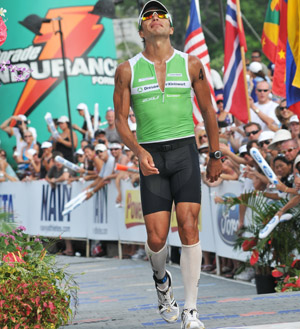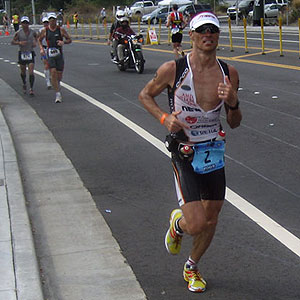Compression sock ban reversed

Just before 7pm EST tonight I received an e-mail with the following statement from Blair LaHaye, the Director of Communications of World Triathlon Corporation. "In response to athlete feedback, World Triathlon Corporation (WTC) has retracted its ban on garments that cover the calves at this year's Ford Ironman World Championship, taking place on October 10, in Kailua-Kona, Hawaii. Because the age of athletes wearing these garments is not visible, Ironman will eliminate marking athletes' ages on calves in Kona to ensure fairness among the field. The tradition of body marking of bib numbers on athletes' arms will remain in place. WTC will continue reviewing this issue and evaluating ways to display ages of participating athletes."
There had been all kinds of speculations and rumors about the "real" reason behind the initial ban of socks and other garments that cover the calves, but now quite a few people will be able to sleep better the next few weeks. Especially the industry people who make compression socks, the Pros who earn money doing so, and the age groupers who have come to accept them as the miracle solution.
It all had started on Friday, September 4th when an email came across my desk that looked like a forwarded press release from the World Triathlon Corp. It stated " Ironman and Ironman 70.3 races is mandatory and marking an athlete’s age group on the calf is part of that process. Athletes competing in our events rely on age group markings on calves to identify their competition. Ironman has been receiving an increasing number of complaints that compression socks and calf guards hide age group identification. At Hawaii 70.3 in June, Ironman experimented with eliminating age group calf markings on all athletes. This attempt at resolving the issue was met by even more complaints by the athletes. Therefore, beginning with the 2009 Ford Ironman World Championship, garments that cover age group calf markings will not be permitted. Ironman’s goal is to design (and my job is to enforce) rules that provide the most level playing field possible." This email was signed by Jimmy Riccitello, the Ironman Head Referee, and a subsequent follow-up email to him confirmed that there was indeed a new rule along those lines. Posted as rule 17 on page 19 of the Kona Athlete’s Guide it simply stated "Any garment, such as tights, compression socks, tube socks, medical tape, etc. that conceals body marking on the calves, will not be permitted." The original email had actually been sent to Richard Verney, a partner in Sports Multiplied, the US distributor of 2XU, and had somehow made its way to other people in the industry. But all of a sudden a "who said what to whom when?" discussion started to overshadow the actual topic of the email and the official "no compression sock" rule, and we decided to follow-up and dig a little deeper to get more details and have some questions answered. After all it was understood that someone racing in Kona would want to know sooner than later what to expect when racing there.

A subsequent post in the Slowtwitch forum had already confirmed that almost no one had heard about it before, but the reactions were swift and quite divided. To those folks who never liked them for their "stupid looks," this was a rule sent from heaven and Jimmy Riccitello became their new hero. Others though seemed quite stunned and annoyed by this rule and all kinds of questions came to the surface. What if I wrote my age and sex on my sock? Does the rule apply to Pros too? What about folks who have sun allergies? Plus various alternative solutions were suggested, ranging from color-coded timing chip bands to having your age group and sex printed on your race number.
Some industry folks had already heard rumblings about this new rule, but the thread on Slowtwitch really started to get the ball rolling.
“We were informed by the WTC about 10 days ago that there is a discussion (about banning compression socks) and that it might happen,” said Brian Enge, CEO of Zoot Sports. “But we did not know it was official until we saw it on Slowtwitch.”
Verney of 2XU even had sent a specific suggestion to WTC that would address the issue and allow folks to wear their socks and calf guards. It was something along the lines of “We have an athlete lounge in Kona and we would heat transfer the official font of the numbers and letters to everyone who would want to race in their socks. We don’t care from which manufacturer the socks might be from, be it Zoot, CEP, SLS3 or whatever else, these athletes can come into the lounge and we’ll add the correct information to their socks at no charge.”
But as it turns out now it appears that the 2XU folks won't have to hastily shop for heat transfers and use up their staff's time for that activity. Instead they can now focus on selling more socks and various other items.
The Pros

Pros would actually have been affected by this ruling as some sponsorship money comes from various compression sock manufacturers. But why Pros would have had the same rule as the age-groupers did not make much sense anyway, considering that they actually have much lower numbers (usually between #1 and #175) and their bib numbers have a different color than the age groupers. Pro men are light blue and Pro women are light pink, and that combined with their low number should leave no doubt about which category they might be racing in. Plus the Pros pretty much know each other anyway.
The opinions of the Pro athletes about this issue varied and Chris Lieto quickly noted: “I think this is awesome. I think they look ridiculous and was not planning on wearing them in any race. I do wear them in some longer training runs and some speed sessions and have found good results, but I try not to be seen with them on.”
2004 and 2006 Ironman World Champion Normann Stadler has raced with them often but has other plans for this year’s Kona race. "I raced in those socks last year but I will not compete in those socks this year," said Stadler. But he added: “I think the rule is not ok. What if I like to race in those old fashioned basketball socks from Nike? Every year – different rules. Next year we ride road bars and only one gear…”
That being said, neither Lieto nor Stadler are currently paid to wear the socks and both have plenty of other sponsors, something many other Pros can’t say. So that makes it is an easy choice for Lieto and Stadler not to wear them to begin with. But since the rule is no longer in place, Normann Stadler will be able to wear Nike basketball socks, and Chris Lieto can smile or cringe when he sees others running around with them on.
The numbers game
The last few years quite a few athletes have competed with compression socks in Kona, and Zoot Sports has counted compression socks the last three years and the growth during those years is quite staggering.
2006 – 16
2007 – 82
2008 – 416 (plus an additional 46 athletes wore compression sleeves)
So basically in 2008 almost 25% of the field were running and / or biking in tall socks of various brands. Verney from 2XU speculated, “as much as half the field might have shown up in Kona this year with compression socks if not for this rule.” That number might be a bit ambitious, but considering the trend of the Zoot sock count, his assumption might not be that far off. And as it turns out now, we will see how good the estimate of Verney actually is.




